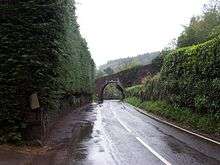Monmouth Railway
| Monmouth Railway | |
|---|---|
| Overview | |
| Type | Horse-drawn plateway |
| Status | Defunct |
| Termini |
May Hill, Monmouth, Wales 51°48′41″N 2°42′27″W / 51.8114°N 2.7076°W Howler Slade, Coleford, Gloucestershire, England 51°47′14″N 2°34′08″W / 51.7872°N 2.5690°W |
| Operation | |
| Opened | 1812 |
| Closed | 1870s |
| Technical | |
| Line length | 5 mi (8.0 km) |
| Track gauge | 3 ft 6 in (1,067 mm) |
The Monmouth Railway, also known as the Monmouth Tramroad, was a horse-drawn railway line which ran for approximately 5 miles (8.0 km) between Monmouth and Coleford, in Gloucestershire. It was opened in 1812 and closed in the 1870s.
History
The Monmouth Railway Company obtained an Act of Parliament on 24 May 1810 for making a railway or tramroad from Howler Slade, in the Forest of Dean to a terminus at May Hill, near Monmouth. The Act specifically allowed for the conveyance of passengers, and is thought to be the first to have done so, although there is no evidence that passengers were carried on a regular basis. It was built as a plateway, horse-drawn wagons with plain wheels running on L-section flanged cast-iron rails. The principal freight carried to Monmouth was coal, clay and lime. The line was opened in 1812. [1] The Monmouth Railway was overtaken by railways however because of the amount of money invested in the tram it was Monmouth's only line until 1857 in spite of the furious complaints from the public about the 'abominable tram way'.[2] In 1861, the Coleford, Monmouth, Usk and Pontypool Railway, which was the first standard-gauge railway to reach Monmouth in 1857, was extended across the River Wye to meet the Monmouth Railway at Wyesham Wharf, where a transshipment point was set up. [3] The arrival of this railway in Monmouth however, along with the Ross and Monmouth Railway in 1873 and the Wye Valley Railway at Redbrook in 1876, meant that the tramroad soon became redundant.
The Coleford Railway, a 1,435 mm (4 ft 8 1⁄2 in) standard gauge railway line was largely built over the route of the tramroad. It was opened on 1 September 1883 but closed on 1 January 1917.
Route

The original route was from Howler Slade, east of Coleford, through Broadwell, then down the Poolway incline into the town of Coleford. The railway then led west down the valley past Whitecliff Ironworks and through a tunnel above Newland. At Redbrook a steep incline led down to the village, providing access to the tinplate factories there, while the main line made a sharp turn to the north, gradually descending the hillside parallel to the River Wye. The terminus was at May Hill, just across the river from Monmouth. Branches from Broadwell led north to the New Found Out coal mine, and south to the Darkhill Ironworks, where it linked with a Severn and Wye Railway branch from Parkend [4]
Remnants
Much of the tramroad was obliterated when the later railway was built, but a number of remnants can be found. The Incline Bridge over the B4231 road at Redbrook (SO537102) is now protected as a Scheduled Ancient Monument. [5] Near Coleford, the stone abutments of a former wooden bridge exist either side of a minor road at SO563101. A section of the original tramroad tunnel remains on private land near Newland.
References
- ↑ The Railways of Monmouth
- ↑ Kissack K, Monmouth: The Making of a County Town, 1975, phillimore & co. LTD, London
- ↑ The Coleford Branch
- ↑ Railways of Monmouth
- ↑ Lower Wye Valley: 015 Upper Redbrook Fieldscape
